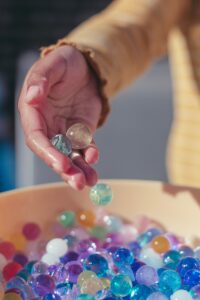Organizing a Sensory Program 
By Debbie Hommel, ACC/MC/EDU, CTRS
Meeting the individualized needs of individuals living with advanced dementia is challenging. Many of our programs involve the ability to remain attentive, long and short term memory and conversational skills. The person living with advanced dementia often does not have these abilities. In the worst-case scenario, they are escorted to a program and sit on the outskirts unable to fully engage. One way to provide appropriate levels of stimulation and possibly generate a response is through an organized sensory stimulation program.
Sensory stimulation is simply defined as the use of everyday objects focusing on the five senses (smell, touch, hearing, sight and taste) to evoke a positive response or generate positive feelings. This approach was first used in 1960’s with individuals with learning disabilities and has since expanded in use with individuals with autism, brain injuries and dementia. Sensory stimulation focuses on two remaining strengths in late-stage dementia: ability to respond emotionally and ability to enjoy sensory cues. The goal is not for the person to correctly identify cues presented (verbalize correct answer to stim provided) but to generate some positive response (smile, eye contact, possibly a memory).
To effectively provide a variety of sensory cues, organizing a sensory program may be helpful. Here are some helpful hints to organize your approaches:
~ Designate a cart or basket or some sort of carrying device for the materials. Having the materials readily accessible will be more time efficient when scheduled to conduct sensory. It is good practice to dedicate materials just to the sensory program and not “borrow” them for other programs. Again, this is to ensure the sensory items are readily available when it is time to do sensory. If materials are shared and borrowed by other programs, sensory time will be wasted looking for the items if they are not returned to the sensory cart. If space is a problem, smaller carts can be adapted. The mini, individual shopping carts that people use to go to the grocery store are smaller and can carry a variety of sensory items.
~Organize materials into storage bins or boxes. You’ll need at least four for the senses – vision, hearing, tactile and olfactory. Additional bins can be organized for life themes, seasonal/holiday themes and individual bins for specific needs. It is best to obtain the bins with attached lids to prevent losing the lids. Clear bins allow for easy review of contents.
~Visual Stimulation Box may include pictures of common objects/familiar things such as animals, babies, people, food, colors, shapes which can easily be found on google image search. The pictures can also be cut from magazines/catalogs (make sure the pictures are large and not complex). Many developmental catalogs offer card sets pre-made. It is good practice to either laminate the cards/images or store in plastic sleeves for protection.
~Olfactory Stimulation Box can include various scents stored in small containers or Ziploc bags. Scents to include are cinnamon, vanilla, coffee, vinegar, baby lotion, toothpaste, peppermint and various extracts. For the liquid scents, pour some drops onto a cotton ball and leave in closed container (prevents spillage).
~Tactile Stimulation Box could include various fabrics such as burlap, velvet, cotton, silk, wool, fur, corduroy, satin, rocks, pieces of rope, various plastic textures, Styrofoam, sandpaper, feathers, cork, and sponges. One can also focus on temperatures with heated items or balloons filled with warm or cold water. Mushy items such as sand in a balloon or many of the commercial tactile balls are also good to include.
~Auditory Stimulation Box may include various bells; sound containers with assorted items to make different sounds such as beans, water, rice, bolts; sound buttons and a variety of music.
~Theme Boxes are important to include. A variety of theme boxes should be included in the program as well. Boxes focusing on the current season and holiday should be accessible on the cart. Some popular life theme boxes should be created based on population need, such as babies, gardening, and men’s interest. The theme boxes would have a variety of sensory items directed to the theme.
It is important to be mindful of safety and infection control procedures. Any small items or items with sharp edges should be closely monitored and possibly not utilized in the program. Policies regarding sharing any sensory items and cleaning items after use should be developed in coordination with the nursing department.
Check out photos of theme oriented sensory baskets on Facebook.

